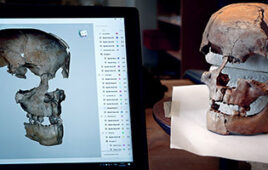
New research suggests microbe biofilms created with a 3D printer could help reduce one of the most damaging greenhouse gases in the atmosphere.
Researchers at Montana State University, the South Dakota School of Mines and Technology and the University of Oklahoma are turning to a microbe called methanotrophs and engineering as a way to combat methane in the atmosphere.
The researchers from Montana State are particularly interested in developing models that explain the metabolism of the microbes and will look at different ways to design and construct biofilms, including using 3D printers that optimize the methanotrophs’s ability to form organic compounds that could be used to produce products like plastics and biofuels.
Jim Wilking, an assistant professor of Chemical and Biological Engineering at Montana State, said in an interview with R&D Magazine that 3D printers will allow the researchers to better control the structure of the microbes.
“We are interested in structuring biofilms using 3D printing, in the same way that bioengineers have been structuring artificial tissue constructs,” he said. “In general, there is a lot of potential for structuring biofilms in a well-controlled way.
“The ability to spatially control multiple components and organize them into a higher order structure is really the power of 3D printing,” he added. “By controlling exquisitely the structure of the microbes you can understand structure function relationships in these systems and that basically allows you to optimize a bioproduct.”
Methanotrophs are capable of converting methane into organic compounds.
Robin Gerlach, a professor in MSU’s Chemical and Biological Engineering Department and the project’s principal investigator at MSU explained the overall goal of the experiment in an interview with R&D Magazine.
“What we are intending to do is understand their metabolism better, understand how they form biofilms slime, which is the lifeform we mostly encounter them in, and ultimately we turn methane from these fairly diffused sources that can have a significant contribution to the global methane flux into the atmosphere,” he said. “Once we know how these organisms work we can hopefully assemble them in a way that is most productive.
“Biofilms have long been known to be some of the most nutrient efficient and productive systems you can find, so they naturally tend to be highly efficient, highly persistent to stress,” he added. “We are really trying to engineer biofilms, we are trying to design and construct biofilms with new, efficient properties to produce bioplastics, high value products, fuels and potentially even electricity.”
Wilking said they plan to use methanotroph-laden drops as a feedstock for 3D printers that have been used to print objects from water-based gels.
By printing the methanotrophs into specific configurations, the researchers may be able to create prototypes of engineered biofilms that can convert methane into different materials.
However, Wilking said there are still some steps that needto be taken before the researchers can 3D print the microbes.
“We are still generating the tools for the 3D printing part of it,” he said. “In our case we are using SLA light-based 3D printers because microbes are way more robust when it comes to exposure to light and the formulation components have become much more efficient.”
The researchers will look for the microbes in thermal features at Yellowstone National Park, as well as the Sanford Underground Research Facility at the site of a former gold mine in South Dakota.
Methane comes from a variety of sources, with large amounts being emitted by agriculture, landfills, oil and coal mining, as well as from natural sources like wetlands.




